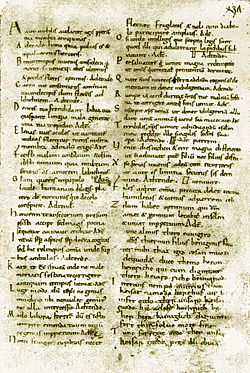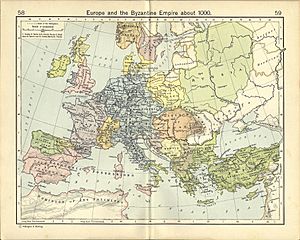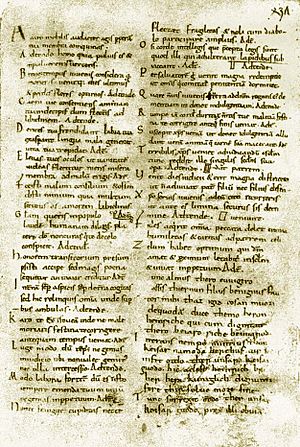Medieval Latin facts for kids
Quick facts for kids Medieval Latin |
|
|---|---|

Carmina Cantabrigiensia, Medieval Latin manuscript
|
|
| Native to | Many small states |
| Region | Most of Europe |
| Era | Developed from Late Latin between 4th and 10th centuries; replaced by Renaissance Latin from the 14th century |
| Language family |
Indo-European
|
| Early forms: |
Old Latin
|
| Writing system | Latin alphabet |
| Official status | |
| Official language in | De facto in most Christian states during the Middle Ages |
| Linguist List | lat-med |

Europe, 1000 AD
|
|
Medieval Latin was a form of the Latin language. People used it during the Middle Ages, which lasted from about the 5th to the 15th century. It was very important in Europe.
Scholars, writers, and people in the Catholic Church used Medieval Latin a lot. It was also the language for science, books, and government work.
Medieval Latin grew out of Late Latin. It was used from around the 4th century until the 14th century. After that, a new form called Renaissance Latin became popular.
Contents
Who Wrote in Medieval Latin?
Many important people wrote in Medieval Latin. Here are some of them:
Writers from the 4th and 5th Centuries
Writers from the 6th to 8th Centuries
- Gildas (died around 570 AD)
- Venantius Fortunatus (about 530-600 AD)
- Gregory of Tours (about 538-594 AD)
- Isidore of Seville (about 560-636 AD)
- Bede (about 672-735 AD)
Writers from the 9th and 10th Centuries
- Ratherius (890-974 AD)
- Thietmar of Merseburg (975-1018 AD)
Images for kids
-
An illuminated manuscript of a Book of Hours contains prayers in medieval Latin.
-
The Prüfening dedicatory inscription from Bavaria, dated to 1119, composed in medieval Latin. It was printed rather than carved.
See also
 In Spanish: Latín medieval para niños
In Spanish: Latín medieval para niños




